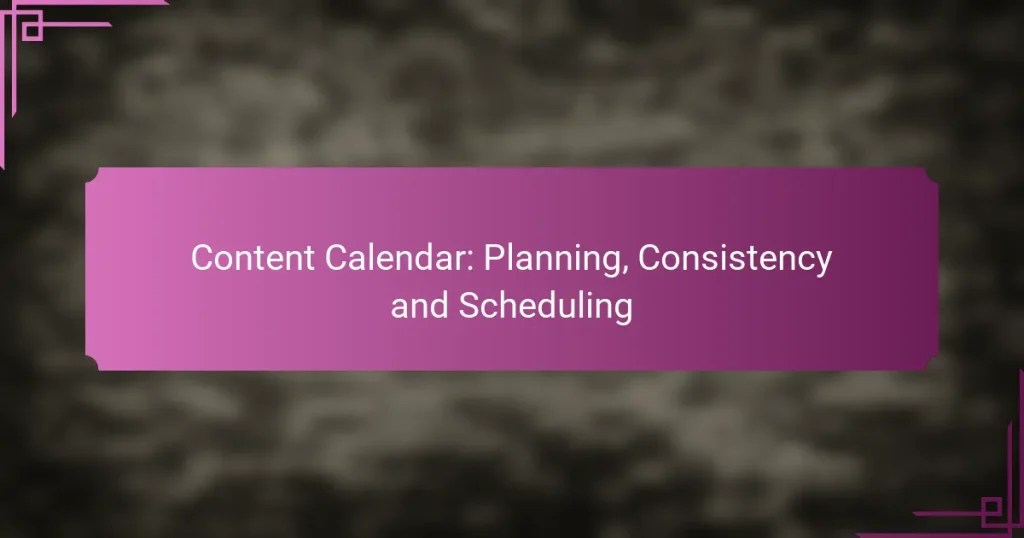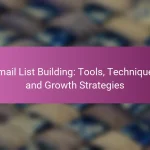Creating an effective content calendar is essential for aligning your content with your goals and audience needs. By planning, scheduling, and maintaining consistency, a well-structured calendar streamlines the content creation process and ensures timely publication, ultimately enhancing audience engagement and trust.
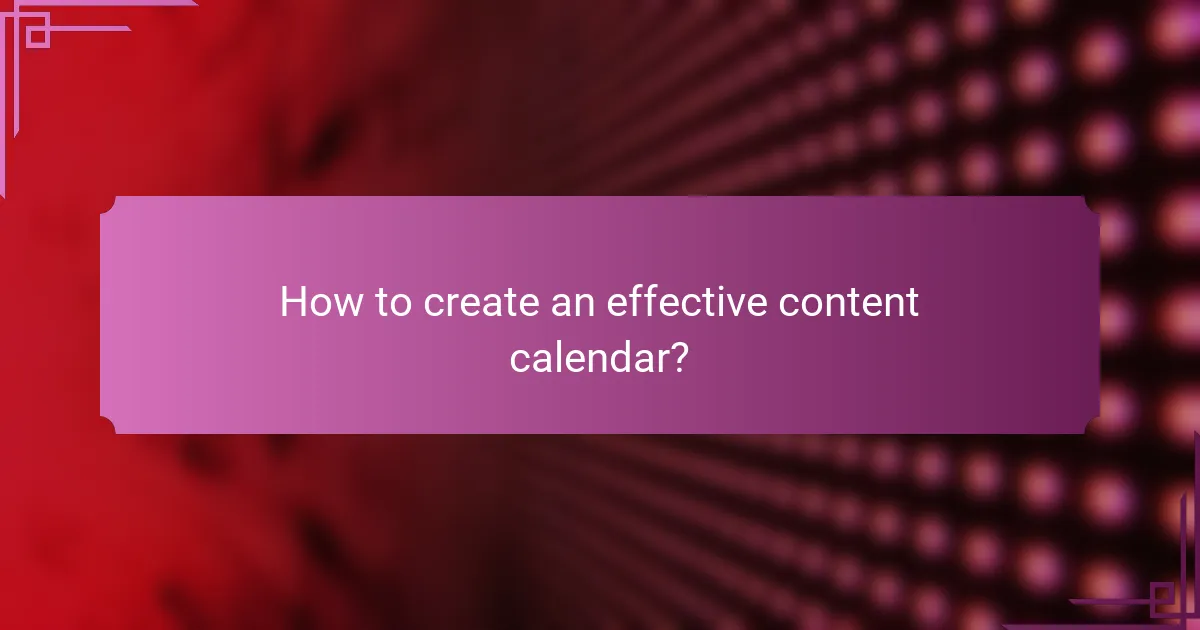
How to create an effective content calendar?
Creating an effective content calendar involves planning, consistency, and scheduling to ensure your content aligns with your goals and audience needs. A well-structured calendar helps streamline content creation and publication, making it easier to maintain a regular posting schedule.
Define content goals
Start by clearly defining your content goals, which should align with your overall business objectives. Whether you aim to increase brand awareness, drive traffic, or generate leads, having specific goals helps guide your content strategy.
Consider using the SMART criteria—Specific, Measurable, Achievable, Relevant, and Time-bound—to create actionable goals. For example, instead of saying “increase website traffic,” specify “increase website traffic by 20% over the next three months.” This clarity will inform your content themes and scheduling.
Choose a scheduling tool
Selecting the right scheduling tool is crucial for managing your content calendar effectively. Options range from simple spreadsheets to dedicated software like Trello, Asana, or CoSchedule, each offering unique features to fit different needs.
Consider factors such as team collaboration, ease of use, and integration with other tools when choosing a scheduling tool. A good tool should allow you to visualize your content plan, set reminders, and track deadlines to keep your team on track.
Identify target audience
Understanding your target audience is essential for creating relevant content. Conduct research to identify demographics, interests, and pain points of your audience, which will inform the type of content you produce.
Utilize tools like Google Analytics and social media insights to gather data on your audience’s behavior. Creating audience personas can also help you tailor your content to meet their specific needs and preferences.
Establish content themes
Content themes help organize your content around specific topics or messages that resonate with your audience. Establishing these themes allows for a cohesive narrative across your content, making it easier for your audience to engage.
Consider seasonal trends, industry events, or customer feedback when selecting themes. For example, if you run a travel blog, you might focus on themes like “summer travel tips” or “budget-friendly destinations” during peak planning seasons.
Set deadlines and milestones
Setting deadlines and milestones is vital for maintaining momentum in your content creation process. Establish clear timelines for each piece of content, from ideation to publication, to ensure accountability within your team.
Consider using a timeline or Gantt chart to visualize deadlines and track progress. Regularly review these deadlines to adjust for any changes in priorities or unexpected delays, ensuring your content calendar remains flexible yet structured.

What are the benefits of a content calendar?
A content calendar provides a structured approach to planning, scheduling, and managing content, leading to more consistent and effective communication. By organizing content in advance, teams can streamline their efforts, ensuring that all necessary topics are covered and deadlines are met.
Improved consistency
Using a content calendar enhances consistency across all platforms and channels. By planning content in advance, teams can maintain a steady flow of posts, which helps to build audience expectations and engagement.
To achieve this, set a regular posting schedule, whether it’s daily, weekly, or monthly. Consistency fosters trust and keeps your audience engaged, making it easier to develop a loyal following.
Enhanced collaboration
A content calendar promotes better collaboration among team members by providing a clear overview of who is responsible for what. This transparency reduces the chances of overlapping efforts or missed deadlines.
Utilizing collaborative tools like Google Sheets or project management software can facilitate real-time updates and feedback. Regular check-ins can further enhance teamwork and ensure everyone is aligned on goals and timelines.
Better time management
Effective time management is a key benefit of a content calendar, allowing teams to allocate resources efficiently. By planning ahead, teams can avoid last-minute rushes and the stress that comes with them.
To optimize time management, consider setting aside specific blocks of time for content creation, review, and publication. This approach helps to ensure that all tasks are completed on schedule, leading to higher quality content and reduced burnout.
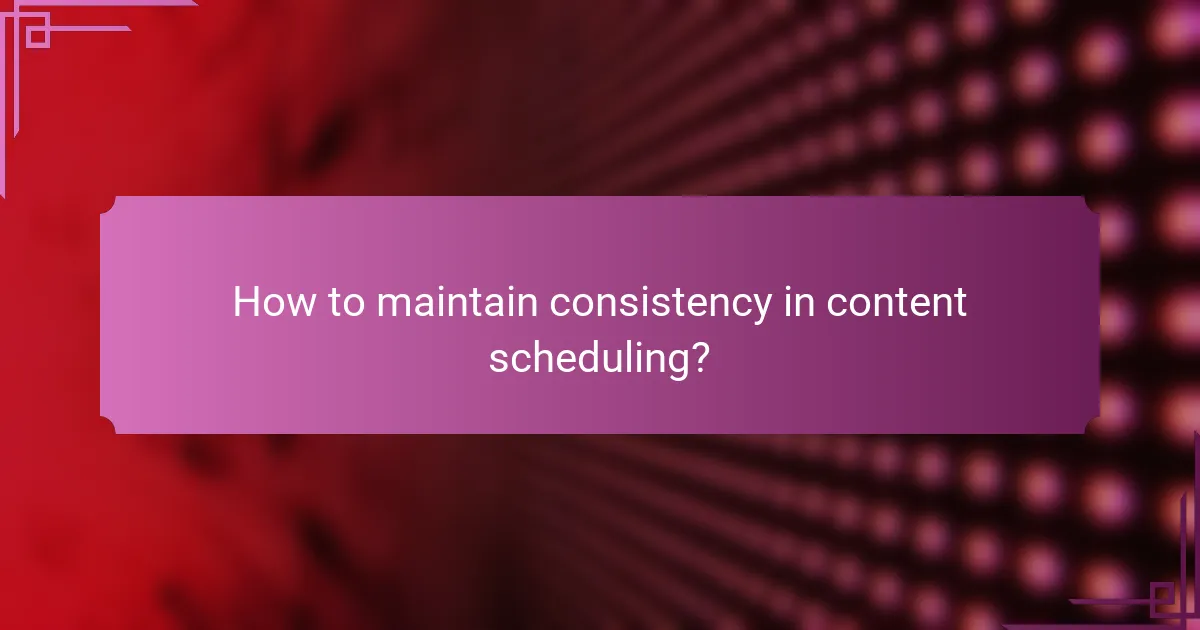
How to maintain consistency in content scheduling?
To maintain consistency in content scheduling, establish a structured plan that includes regular updates and reviews. This ensures that your content remains relevant and timely, fostering audience engagement and trust.
Regular review sessions
Regular review sessions are essential for evaluating your content calendar’s effectiveness. Schedule these sessions weekly or monthly to assess what types of content resonate with your audience and adjust your strategy accordingly.
During these reviews, analyze performance metrics such as engagement rates and traffic sources. This data helps identify successful content and areas needing improvement, allowing you to refine your approach.
Automated reminders
Automated reminders can significantly enhance your content scheduling consistency. Utilize tools like Google Calendar or project management software to set reminders for content creation, publication dates, and review sessions.
These reminders help you stay on track and ensure that deadlines are met. Consider setting reminders a few days in advance to give yourself ample time for any last-minute adjustments.
Content repurposing strategies
Content repurposing strategies allow you to maximize the value of existing content by adapting it for different formats or platforms. For example, transform a blog post into an infographic or a video, reaching diverse audience segments.
Identify high-performing content that can be refreshed or updated with new information. This not only saves time but also reinforces your brand message across multiple channels, enhancing overall consistency in your content delivery.
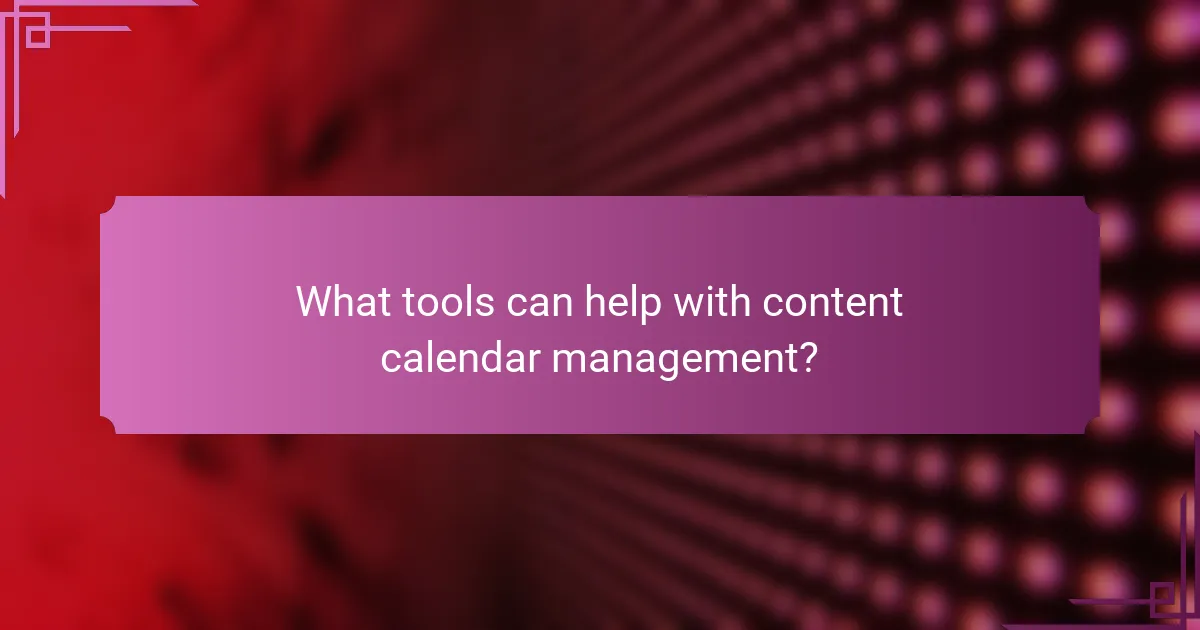
What tools can help with content calendar management?
Effective content calendar management can be streamlined with various tools designed for organization, scheduling, and marketing. Utilizing the right software can enhance collaboration, improve consistency, and ensure timely content delivery.
Trello for project management
Trello is a visual project management tool that uses boards, lists, and cards to organize tasks. It allows teams to track content creation stages, assign responsibilities, and set deadlines easily. You can create a board specifically for your content calendar, adding cards for each piece of content to visualize progress.
To maximize Trello’s effectiveness, consider using labels for content types, due dates for scheduling, and checklists for tracking completion steps. This helps maintain clarity and accountability within your team.
Google Calendar for scheduling
Google Calendar is a straightforward scheduling tool that integrates well with other Google services. It allows you to create events for each content piece, set reminders, and share calendars with your team. This ensures everyone is aware of upcoming deadlines and can plan accordingly.
Utilize color-coding to differentiate between content types or campaigns, and set recurring events for regular content updates. This helps maintain a consistent publishing schedule and keeps your team aligned.
CoSchedule for marketing
CoSchedule is a comprehensive marketing calendar that combines content scheduling with social media management. It allows you to plan, publish, and promote content all in one place, making it easier to coordinate marketing efforts. You can visualize your entire marketing strategy and adjust as needed.
Take advantage of CoSchedule’s analytics features to track performance metrics and optimize your content strategy. This data-driven approach can help you refine your calendar based on what resonates with your audience, enhancing overall effectiveness.

How to evaluate the effectiveness of a content calendar?
Evaluating the effectiveness of a content calendar involves assessing how well it drives engagement, traffic, and audience satisfaction. Key metrics and feedback mechanisms can provide insights into its performance and areas for improvement.
Track engagement metrics
Engagement metrics such as likes, shares, comments, and time spent on content are crucial for understanding audience interaction. Regularly monitor these metrics to identify which types of content resonate most with your audience.
Consider setting benchmarks based on past performance. For example, aim for a 10-20% increase in engagement over a quarter to gauge improvement. Tools like Google Analytics or social media insights can help track these metrics effectively.
Analyze traffic sources
Understanding where your traffic originates is essential for evaluating your content calendar’s effectiveness. Analyze traffic sources such as organic search, social media, and referrals to determine which channels are most productive.
Utilize tools like Google Analytics to break down traffic by source. If social media is driving significant traffic, consider increasing your posting frequency or diversifying your content types on those platforms.
Gather audience feedback
Collecting feedback directly from your audience can provide valuable insights into the effectiveness of your content calendar. Use surveys, polls, or comment sections to ask for opinions on content relevance and quality.
Incorporate feedback mechanisms regularly, such as quarterly surveys, to adjust your strategy based on audience preferences. This can help ensure your content remains engaging and aligned with audience expectations.
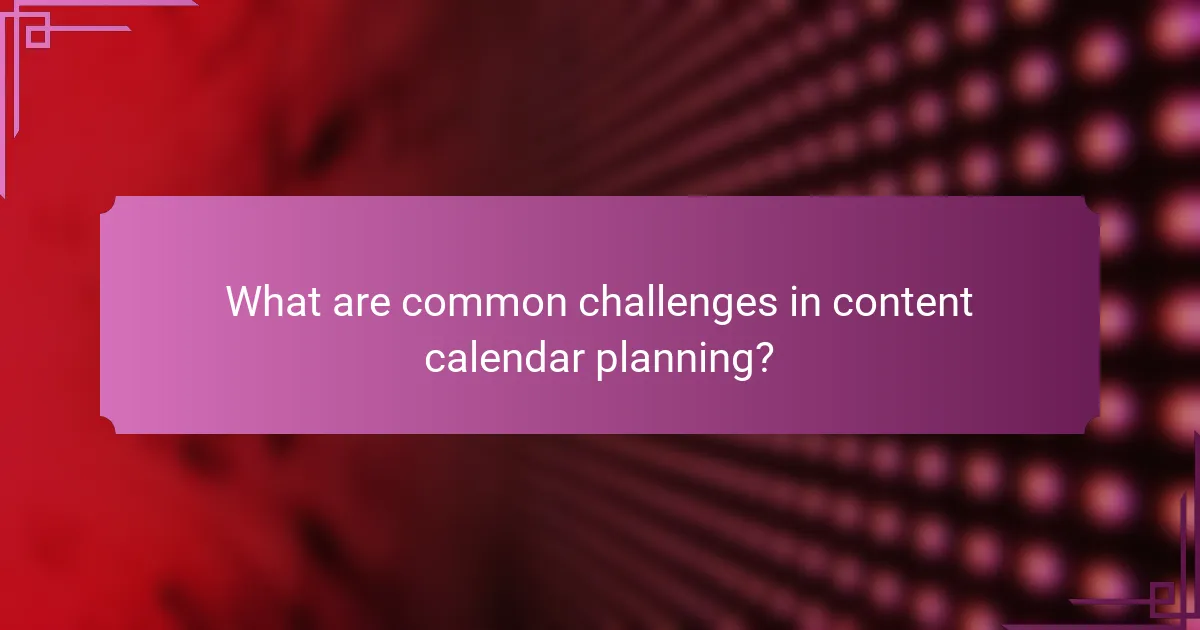
What are common challenges in content calendar planning?
Common challenges in content calendar planning include maintaining consistency, aligning content with business goals, and managing deadlines. These obstacles can hinder effective content creation and distribution, leading to missed opportunities and reduced audience engagement.
Inconsistent content scheduling
Inconsistent content scheduling can disrupt audience expectations and engagement. To combat this, establish a regular posting frequency that aligns with your audience’s habits, such as weekly or bi-weekly updates. Use tools like Google Calendar or Trello to visualize and stick to your schedule.
Difficulty in aligning content with business goals
Aligning content with business goals is crucial for maximizing impact. Begin by clearly defining your objectives, such as increasing brand awareness or driving sales. Regularly review your content calendar to ensure each piece supports these goals, adjusting as necessary to keep your strategy on track.
Managing multiple contributors and deadlines
Managing multiple contributors can lead to confusion and missed deadlines. Implement a clear workflow that outlines responsibilities for each team member, including deadlines for drafts and approvals. Regular check-ins can help keep everyone accountable and ensure that the content calendar remains on schedule.
